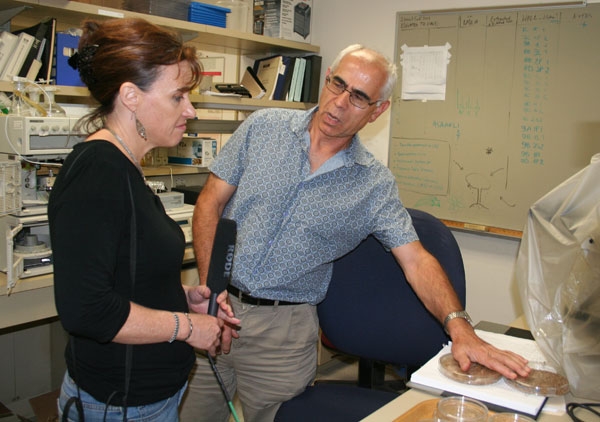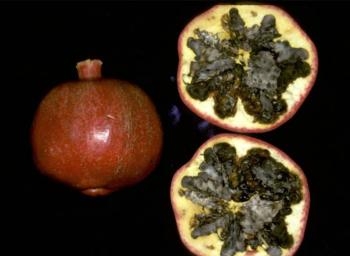Posts Tagged: Themis Michailides
'Great Day' morning program features UC Kearney Ag REC
The popular morning television program "Great Day," which airs daily on KMPH Channel 26 in Fresno, featured the work of scientists at the UC Kearney Agricultural Research and Extension Center in six live segments during the five-hour program this morning.
Reporter Clayton Clark and photographer Ryan Hudgins arrived at the Kearney greenhouse at 4:30 a.m. to interview the scientists helping California farmers feed the nation and world sustainably.
See clips of the interviews in the one-minute video below:
Segments included:
- An overview of research and extension activities at Kearney by director Jeff Dahlberg.
- UC blueberry and blackberry research that has made these commodities important crops in the San Joaquin Valley with Manuel Jimenez, UC Cooperative Extension farm advisor in Tulare County.
- Beneficial insects, pests and invasive species that are part of research by Kent Daane, UCCE specialist in the Department of Environmental Science and Policy Management at UC Berkeley. Daane shared a handful of leaf-footed bugs with the reporter.
- How global information systems are changing the way farmers and researchers are looking at farmings systems with Kris Lynn-Patterson, coordinator of the GIS program at Kearney.
- Just like people, plants get sick. UC plant pathologist Themis Michailides explained research efforts to cure plant diseases.
- Uncommon wine varieties that might lead to new fine wines ideally suited to be produced in the Valley's warm climate, with Matt Fidelibus, UCCE specialist in the Department of Viticulture and Enology at UC Davis.
- The very real threat of West Nile virus in mosquitoes in the valley, with medical entomologist Anton Cornel.
Pistachio crop threatened by fungus
The California Report, a popular radio news program that is broadcast throughout the state on public radio stations, devoted five minutes this morning to a solution found at the UC Kearney Agricultural Research and Extension Center for a serious pistachio production problem.
Reporter Alice Daniel interviewed Kearney-based UC Davis plant pathologist Themis Michailides, who led the team that discovered how to expose pistachio trees to spores of a beneficial fungus that displaces the fungi that produce aflatoxin.
Though the story was broadcast this morning, it can still be heard on The California Report website and is embedded below:
For more information on the beneficial fungus, AF-36, which was used for the first time in commercial pistachio orchards this past summer, read Pistachio farmers enlist a beneficial fungus to battle aflatoxin.
UC scientists studying 'baffling' pomegranate ailment
A mysterious sudden crippling or death of pomegranate trees may be due to cold temperatures, said a story in Western Farm Press.
Three farmers and Themis Michiliades, UC Davis plant pathologist based at the UC Kearney Agricultural Research and Extension Center, agreed that low temperatures have a lot to do with the problem. Michailides cited an Iranian research paper that showed similar cold snap damage. Michailides and Richard Molinar, UC Cooperative Extension farm advisor in Fresno County, said damage from dieback this year was more common in sandier soils, perhaps because heavier soils hold moisture.
Writer Dennis Pollock reported on the problem in his article about a recent pomegranate field day at Kearney. At the field day, Michailides also reported on "black heart" of pomegranate, caused by Altenaria fungus, and cankers caused by species that include Neofusicoccum mediterraneum.
Claude Phené, a retired USDA-ARS researcher, discussed a two-year-old pomegranate irrigation and fertigation trial at Kearney.
Pistachio farmers enlist a beneficial fungus to battle aflatoxin
Research conducted over the past 11 years at the UC Kearney Agricultural Research and Extension Center in Parlier, Calif., will help ensure the safety of California’s $1.16 billion pistachio crop. This summer, for the first time, a beneficial fungus is being used in San Joaquin Valley pistachio orchards to protect the nuts from aflatoxin contamination.
Aflatoxin can form on a wide variety of crops, from corn to cotton to tree nuts. Careful management practices help keep levels low, but still hundreds of thousands of pounds of pistachios are rejected each year due to the presence of aflatoxin.
UC Davis plant pathologist Themis Michailides and his team of researchers at Kearney discovered how to expose pistachio trees to the spores of a beneficial fungus that displaces the fungi that produce aflatoxin. Displacing aflatoxigenic fungi with a beneficial fungus has never before been done in tree crops.
“We’ve gotten great results,” Michailides said. “The reduction in aflatoxin contaminated nuts has been up to 45 percent. We anticipate higher reduction with application of the beneficial fungus for multiple years and on larger acreage.”
The new process was approved by the U.S. Environmental Protection Agency in February and the California Department of Pesticide Regulation in May, in time for 60,000 acres of the 2012 California pistachio crop to receive the innovative treatment.
“This is a big step,” Michailides said. “There will be a tremendous savings to pistachio growers by reducing rejections and the need for resorting nuts before going to market.”
Aflatoxin was discovered in the 1960s when a flock of turkeys in England died after eating contaminated feed. Aflatoxin is produced by certain strains of the fungus Aspergillus flavus, which is commonly found in soil and decaying vegetation. Aflatoxin is a resilient foe. Roasting nuts does not destroy the toxin. Other crops, such as corn and cottonseed used as animal feed, can be treated with ammonia to reduce aflatoxin, however ammonia treatment is not possible for human food, such as tree nut crops.
All shipments of pistachios are tested for aflatoxins, and are rejected in Europe if contamination exceeds 10 parts per billion and in the United States if shipments have more than 15 parts per billion.
The use of beneficial fungi to fight aflatoxin was first discovered and investigated by Peter Cotty, a USDA Agricultural Research Service plant pathologist located in the School of Plant Sciences at the University of Arizona. Cotty’s research focuses on reducing aflatoxin presence in corn and cottonseed. In collaboration with Cotty, Michailides and his colleague Mark Doster, staff research associate in the Michailides lab at Kearney, found that Aspergillus flavus 36 (AF36) can be introduced into an orchard by inoculating “dead” wheat seeds and then dispersing the seeds on the orchard floor. Dew and soil moisture spur the development of harmless spores that colonize pistachios and prevent colonization by toxigenic fungus strains.
The Kearney scientists are continuing their cooperation with USDA’s Cotty as they expand the research to almonds and figs.
“We’re conducting micro-plot experiments with the almond industry at Kearney,” Michailides. “We hope to get an experimental use permit soon to make the treatment available to almond growers.”
Michailides’ aflatoxin research was funded by USDA, the California Pistachio Research Board, the Almond Board of California and a UC Discovery Grant. The research was made possible by the involvement of cooperating pistachio growers who opened their orchards to scientists for conducting AF36 trials.



